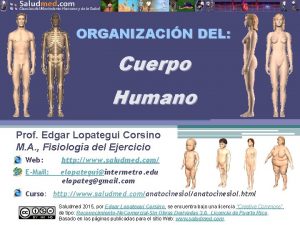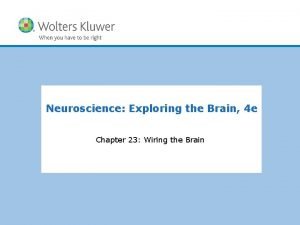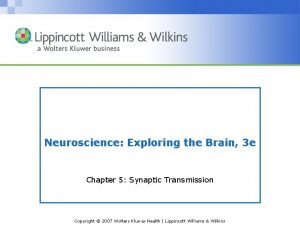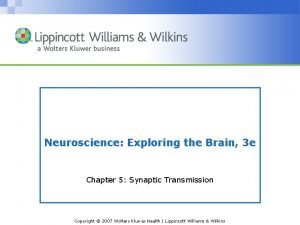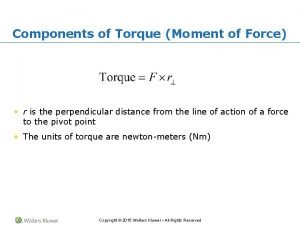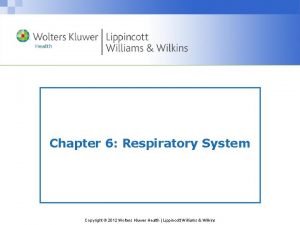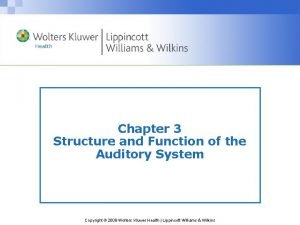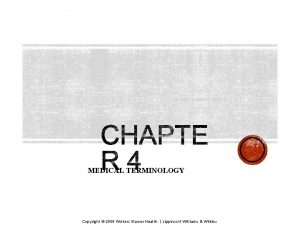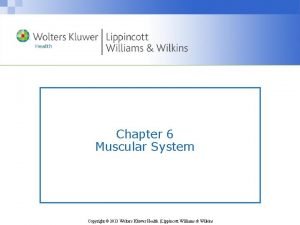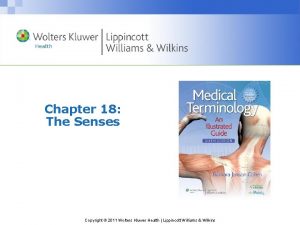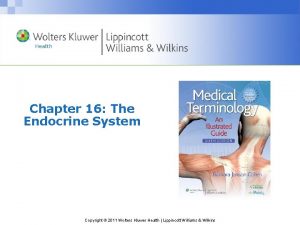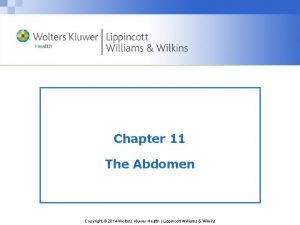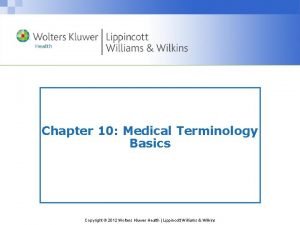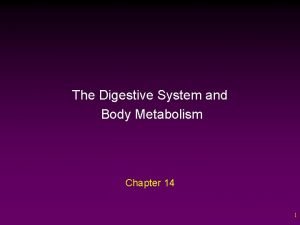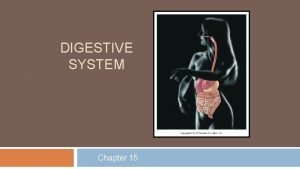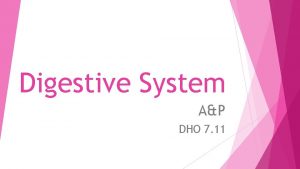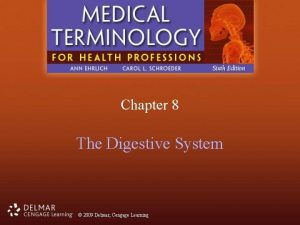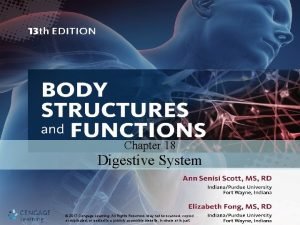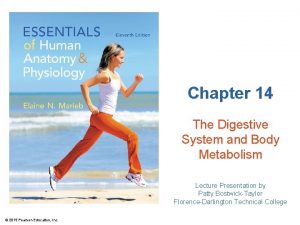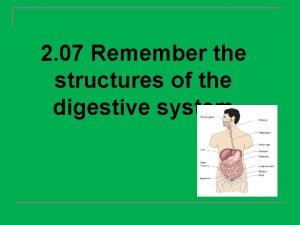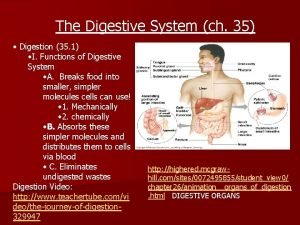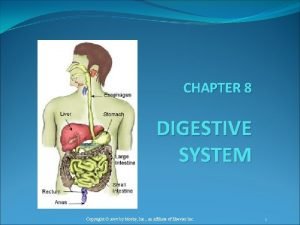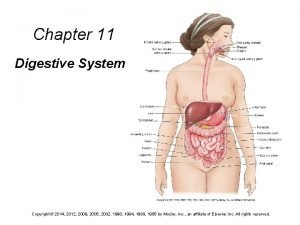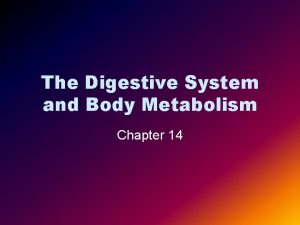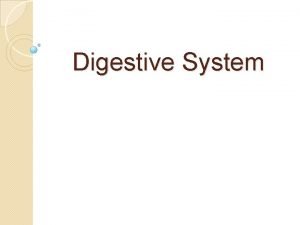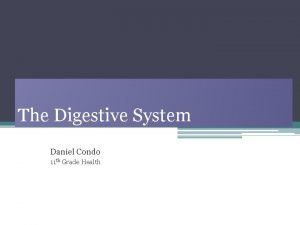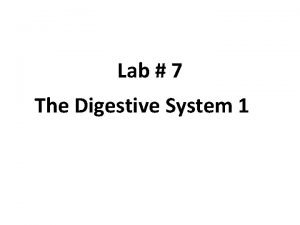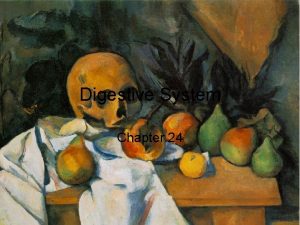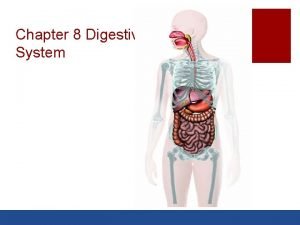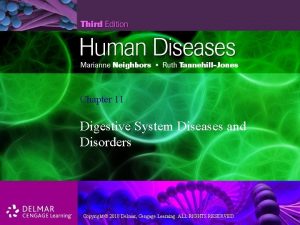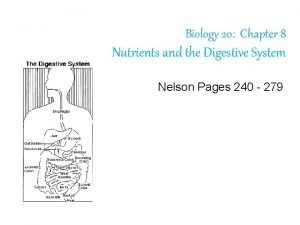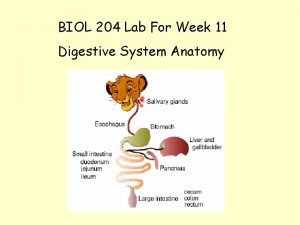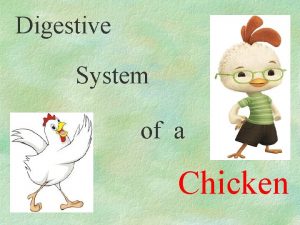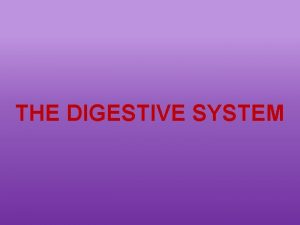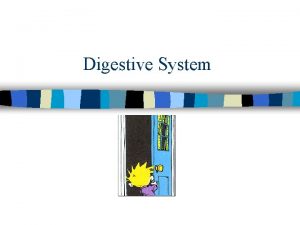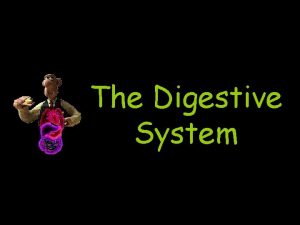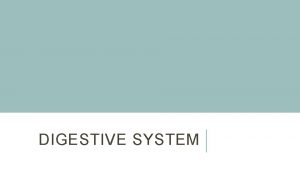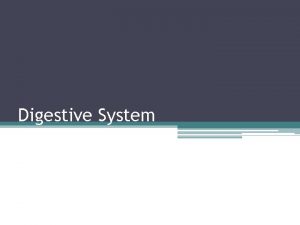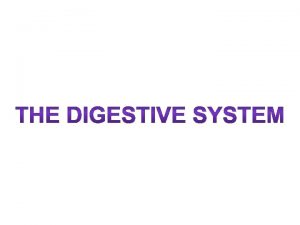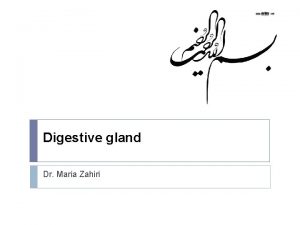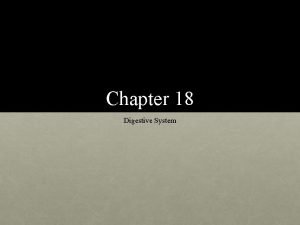Chapter 19 The Digestive System Copyright 2015 Wolters









































































- Slides: 73

Chapter 19 The Digestive System Copyright © 2015 Wolters Kluwer Health | Lippincott Williams & Wilkins

Key Terms absorption esophagus pancreas bile gallbladder peptic ulcer chyle hydrolysis peristalsis chyme ingestion peritoneum defecation intestine saliva deglutition lacteal sphincter digestion liver stomach duodenum mastication villi emulsify mesentery Copyright © 2015 Wolters Kluwer • All Rights Reserved

General Structure and Function of the Digestive System General Functions • Digestion • Absorption • Elimination Divisions • Digestive tract • Accessory organs Copyright © 2015 Wolters Kluwer • All Rights Reserved

Figure 19 -1 The digestive system. Which accessory organs of digestion secrete into the mouth? Copyright © 2015 Wolters Kluwer • All Rights Reserved

General Structure and Function of the Digestive System (cont. ) Peritoneum • Lines the abdominopelvic cavity; covers abdominal organs • Layers of the peritoneum – Parietal – Visceral • Subdivisions – Mesentery – Mesocolon – Greater omentum – Lesser omentum Copyright © 2015 Wolters Kluwer • All Rights Reserved

General Structure and Function of the Digestive System (cont. ) The Wall of the Digestive Tract • Mucosal membrane, or mucosa • Submucosa • Smooth muscle, the muscularis externa • Serous membrane, or serosa Copyright © 2015 Wolters Kluwer • All Rights Reserved

Figure 19 -3 Wall of the digestive tract. What type of tissue is between the submucosa and the serous membrane in the digestive tract wall? Copyright © 2015 Wolters Kluwer • All Rights Reserved

General Structure and Function of the Digestive System (cont. ) Pop Quiz 19. 1 ? Which of the following is the correct order from the outermost to innermost layer? A) Submucosa, serous membrane, smooth muscle, mucous membrane B) Smooth muscle, serous membrane, mucous membrane, submucosa C) Serous membrane, smooth muscle, submucosa, mucosa D) Mucous membrane, submucosa, smooth muscle, serous membrane Copyright © 2015 Wolters Kluwer • All Rights Reserved

General Structure and Function of the Digestive System (cont. ) Pop Quiz Answer 19. 1 ? Which of the following is the correct order from the outermost to innermost layer? A) Submucosa, serous membrane, smooth muscle, mucous membrane B) Smooth muscle, serous membrane, mucous membrane, submucosa C) Serous membrane, smooth muscle, submucosa, mucosa D) Mucous membrane, submucosa, smooth muscle, serous membrane Copyright © 2015 Wolters Kluwer • All Rights Reserved

Organs of the Digestive Tract (cont. ) • Mouth • Pharynx • Esophagus • Stomach • Small intestine • Large intestine Copyright © 2015 Wolters Kluwer • All Rights Reserved

Organs of the Digestive Tract (cont. ) The Mouth • Also called oral cavity, processes food by: – Ingestion – Mastication – Mixing with saliva – Deglutition • Tongue Copyright © 2015 Wolters Kluwer • All Rights Reserved

Figure 19 -4 Gastrointestinal motility. Which type of motility would be most useful in the esophagus, where the contents should move quickly? Copyright © 2015 Wolters Kluwer • All Rights Reserved

Organs of the Digestive Tract (cont. ) The Teeth • Sets of teeth – Deciduous – Permanent • Types of teeth – Incisors – Cuspids – Molars • Six-year molars • Premolars • Third molars or wisdom teeth Copyright © 2015 Wolters Kluwer • All Rights Reserved

Organs of the Digestive Tract (cont. ) The Teeth (cont. ) • Parts of a tooth – Dentin – Crown – Enamel – Root • The gum – Gingiva Copyright © 2015 Wolters Kluwer • All Rights Reserved

Figure 19 -5 The mouth and teeth. Copyright © 2015 Wolters Kluwer • All Rights Reserved

Copyright © 2015 Wolters Kluwer • All Rights Reserved

Organs of the Digestive Tract (cont. ) The Pharynx • Also called the throat • Divisions – Oropharynx – Nasopharynx – Laryngopharynx • Soft palate • Uvula Copyright © 2015 Wolters Kluwer • All Rights Reserved

Organs of the Digestive Tract (cont. ) The Esophagus • Muscular tube. • Food is lubricated with mucus. • Peristalsis. • No digestion occurs here. • Passes through esophageal hiatus of the diaphragm to join stomach. Copyright © 2015 Wolters Kluwer • All Rights Reserved

Organs of the Digestive Tract (cont. ) The Stomach • Structure – Greater curvature – Lesser curvature – Fundus – Body – Pylorus • Sphincters – Lower esophageal sphincter (LES) – Pyloric Copyright © 2015 Wolters Kluwer • All Rights Reserved

Organs of the Digestive Tract (cont. ) The Stomach (cont. ) • Functions – Storage pouch • Rugae – Secrete substances to form gastric juice • Hydrochloric acid prepares proteins for digestion. • Pepsin digests proteins. – Delivery of chyme to the small intestine Copyright © 2015 Wolters Kluwer • All Rights Reserved

Organs of the Digestive Tract (cont. ) The Small Intestine • Subdivisions of the small intestine – Duodenum – Jejunum – Ileum • Functions of the small intestine – Secretion – Motility – Digestion – Absorption Copyright © 2015 Wolters Kluwer • All Rights Reserved

Figure 19 -7 The intestines. Copyright © 2015 Wolters Kluwer • All Rights Reserved

Organs of the Digestive Tract (cont. ) The Large Intestine • Subdivisions of the large intestine – Cecum • Ileocecal valve • Appendix – Ascending colon – Transverse colon – Descending colon – Sigmoid colon – Rectum – Anal canal – Anus Copyright © 2015 Wolters Kluwer • All Rights Reserved

Organs of the Digestive Tract (cont. ) • Functions of the large intestine – Production of mucus – Reabsorb some water – Form feces (stool) – Defecation Copyright © 2015 Wolters Kluwer • All Rights Reserved

Organs of the Digestive Tract (cont. ) Pop Quiz ? 19. 2 Which organ receives food flowing through the pyloric sphincter? A) Stomach B) Jejunum C) Duodenum D) Esophagus Copyright © 2015 Wolters Kluwer • All Rights Reserved

Organs of the Digestive Tract (cont. ) Pop Quiz Answer ? 19. 2 Which organ receives food flowing through the pyloric sphincter? A) Stomach B) Jejunum C) Duodenum D) Esophagus Copyright © 2015 Wolters Kluwer • All Rights Reserved

The Accessory Organs (cont. ) • Release secretions through ducts into the digestive tract. • Salivary glands open to mouth. • Other organs release secretions into the duodenum: – Liver – Gallbladder – Pancreas Copyright © 2015 Wolters Kluwer • All Rights Reserved

The Accessory Organs (cont. ) Salivary Glands • Functions -Secrete saliva • Moistens food • Facilitates mastication and deglutition • Helps keep teeth and mouth clean • Three pairs: – Parotid glands – Submandibular glands – Sublingual glands Copyright © 2015 Wolters Kluwer • All Rights Reserved

The Accessory Organs (cont. ) The Liver • Structure of the liver – Largest accessory organ – Right, left lobes – Portal vein – Hepatic artery Copyright © 2015 Wolters Kluwer • All Rights Reserved

The Accessory Organs (cont. ) The Liver (cont. ) • Functions of the liver – Manufactures bile – Controls blood glucose levels – Modifies fats – Stores some vitamins, iron – Forms blood plasma proteins – Destroys old red blood cells – Synthesizes urea – Detoxifies harmful substances Copyright © 2015 Wolters Kluwer • All Rights Reserved

The Accessory Organs (cont. ) The Liver (cont. ) • Bile – Manufactured in the liver. – Bile leaves the liver by ducts. • Common hepatic duct • Cystic duct • Common bile duct Copyright © 2015 Wolters Kluwer • All Rights Reserved

Figure 19 -9 Accessory organs of digestion. Into which part of the small intestine do these accessory organs secrete? Copyright © 2015 Wolters Kluwer • All Rights Reserved

The Accessory Organs (cont. ) The Gallbladder • Muscular sac • Located on inferior surface of the liver • Stores bile Copyright © 2015 Wolters Kluwer • All Rights Reserved

The Accessory Organs (cont. ) The Pancreas • Gland that produces enzymes • Releases large amounts of sodium bicarbonate (Na. HCO 3) • Also functions as an endocrine gland Copyright © 2015 Wolters Kluwer • All Rights Reserved

Enzymes and the Digestive Process (cont. ) • Fundamental chemical process of digestion • Enzymes – Required for digestion – Catalysts – Highly specific proteins Copyright © 2015 Wolters Kluwer • All Rights Reserved

Copyright © 2015 Wolters Kluwer • All Rights Reserved

Enzymes and the Digestive Process (cont. ) Role of Water • Hydrolysis • Seven liters of water secreted into the digestive tract daily • Produces digestive juices • Dilutes food • Used in the chemical process of digestion Copyright © 2015 Wolters Kluwer • All Rights Reserved

Figure 19 -10 Hydrolysis. Copyright © 2015 Wolters Kluwer • All Rights Reserved

Digestion, Step by Step Digestion in the Mouth • Chews food, mixes with saliva • Some starches changed to sugars via salivary amylase Digestion in the Stomach • Secretes HCl, enzymes – Denatures proteins • Secretes mucus • Forms chyme Copyright © 2015 Wolters Kluwer • All Rights Reserved

Digestion, Step by Step (cont. ) Digestion in the Small Intestine Most digestion occurs in the duodenum. • Fats • Carbohydrates • Proteins • Nucleic acids Copyright © 2015 Wolters Kluwer • All Rights Reserved

Absorption (cont. ) • Villi in mucosa of the small intestine: – Arteriole and venule bridged with capillaries • Capillaries absorb: – Simple sugars – Small proteins – Amino acids – Simple fatty acids – Water • Portal system transports nutrients to the liver. Copyright © 2015 Wolters Kluwer • All Rights Reserved

Absorption (cont. ) • Absorption of fats – Lacteals absorb fat. – Fat/lymph mixture (chyle) drains from the small intestine. – Chyle merges with lymphatic circulation, enters blood in veins near the heart. – The liver further processes absorbed fats. Copyright © 2015 Wolters Kluwer • All Rights Reserved

Absorption (cont. ) • Absorption of vitamins and minerals – Vitamins and minerals are absorbed from the small intestine. – Minerals and some vitamins mix with water and are absorbed directly into the blood. – Other vitamins are incorporated in fats and absorbed along with fats. – Vitamin K and some B vitamins are produced by bacterial action in the colon and are absorbed from the large intestine. Copyright © 2015 Wolters Kluwer • All Rights Reserved

Figure 19 -11 Carbohydrates. Name the two monosaccharide components of sucrose. Copyright © 2015 Wolters Kluwer • All Rights Reserved

Enzymes and the Digestive Process (cont. ) Pop Quiz ? 19. 3 Which enzyme digests carbohydrates? A) Amylase B) Pepsin C) Lipase D) Trypsin Copyright © 2015 Wolters Kluwer • All Rights Reserved

Enzymes and the Digestive Process (cont. ) Pop Quiz Answer ? 19. 3 Which enzyme digests carbohydrates? A) Amylase B) Pepsin C) Lipase D) Trypsin Copyright © 2015 Wolters Kluwer • All Rights Reserved

Control of Digestion and Eating (cont. ) Control of Digestion Two types of control over digestion—nervous and hormonal • Nervous control of digestion – Parasympathetic stimulation increases activity – Sympathetic stimulation decreases activity • Hormonal control of digestion – Digestive organs produce hormones • Gastrin • Gastric inhibitory peptide (GIP) • Secretin • Cholecystokinin (CCK) Copyright © 2015 Wolters Kluwer • All Rights Reserved

Control of Digestion and Eating (cont. ) Control of Hunger and Appetite • Hunger – Desire for food – Regulated by hypothalamic centers – Respond to nutrient levels – Satisfied by adequate meal • Appetite – No relationship to need for food – May not be satisfied by adequate meal Copyright © 2015 Wolters Kluwer • All Rights Reserved

Control of Digestion and Eating (cont. ) • Short-term regulation of hunger – Hypothalamus induces hunger sensations – Ghrelin hormone – Food consumption • Long-term regulation of body weight – Leptin hormone produced by adipocytes Copyright © 2015 Wolters Kluwer • All Rights Reserved

Figure 19 -12 Regulation of food intake. Copyright © 2015 Wolters Kluwer • All Rights Reserved

Control of Digestion and Eating (cont. ) Pop Quiz ? 19. 4 Which portion of the autonomic nervous system inhibits digestion? A) Somatic B) Parasympathetic C) Sympathetic D) Visceral Copyright © 2015 Wolters Kluwer • All Rights Reserved

Control of Digestion and Eating (cont. ) Pop Quiz Answer ? 19. 4 Which portion of the autonomic nervous system inhibits digestion? A) Somatic B) Parasympathetic C) Sympathetic D) Visceral Copyright © 2015 Wolters Kluwer • All Rights Reserved

Disorders of the Digestive System (cont. ) Peritonitis • Inflammation of the peritoneum following infection of an organ covered by peritoneum – Localized – Generalized • Examples of causative factors: ruptured appendix, perforated ulcer, penetrating wound Copyright © 2015 Wolters Kluwer • All Rights Reserved

Disorders of the Digestive System (cont. ) Diseases of the Mouth and Teeth • Dental caries • Gingivitis • Periodontitis • Vincent disease • Oral thrush • Parotitis Copyright © 2015 Wolters Kluwer • All Rights Reserved

Disorders of the Digestive System (cont. ) Disorders of the Esophagus and Stomach • Hiatal hernia and gastric reflux – Heartburn – Chronic reflux or gastroesophageal reflux disease (GERD) • Nausea and vomiting (emesis) • Stomach cancer • Gastritis and peptic ulcer • Pyloric stenosis Copyright © 2015 Wolters Kluwer • All Rights Reserved

Figure 19 -13 Disorders involving the esophagus and stomach. Copyright © 2015 Wolters Kluwer • All Rights Reserved

Copyright © 2015 Wolters Kluwer • All Rights Reserved

Disorders of the Digestive System (cont. ) Intestinal Disorders • Inflammatory disorders – Appendicitis – Inflammatory bowel disease • Crohn disease • Ulcerative colitis – Celiac disease – Irritable bowel syndrome (IBS) – Enteritis and gastroenteritis – Diverticulitis Copyright © 2015 Wolters Kluwer • All Rights Reserved

Copyright © 2015 Wolters Kluwer • All Rights Reserved

Disorders of the Digestive System (cont. ) Intestinal Disorders (cont. ) • Diarrhea • Constipation – Spastic constipation – Flaccid constipation • Intestinal obstruction – Intussusception – Volvulus • Colon and rectal cancer – Sigmoidoscope – Colonoscope Copyright © 2015 Wolters Kluwer • All Rights Reserved

Figure 19 -14 Intestinal obstructions. Copyright © 2015 Wolters Kluwer • All Rights Reserved

Figure 19 -15 Imaging of the colon. Copyright © 2015 Wolters Kluwer • All Rights Reserved

Disorders of the Digestive System (cont. ) Cirrhosis and Other Liver Diseases • Cirrhosis – Active liver cells replaced by inactive connective (scar) tissue. – Alcoholic (portal) cirrhosis is most common type. – Varicose veins (varices) of the digestive tract. • Jaundice • Hepatitis – Types of hepatitis virus: A, B, C, D, E • Liver cancer Copyright © 2015 Wolters Kluwer • All Rights Reserved

Copyright © 2015 Wolters Kluwer • All Rights Reserved

Disorders of the Digestive System (cont. ) Gallstones • Cholelithiasis • Cholecystitis Pancreatic Disorders • Pancreatitis • Pancreatic cancer Copyright © 2015 Wolters Kluwer • All Rights Reserved

Figure 19 -16 Gallstones. Copyright © 2015 Wolters Kluwer • All Rights Reserved

Copyright © 2015 Wolters Kluwer • All Rights Reserved

Effects of Aging and the Digestive System • Decreased digestive organ activity – Decrease in saliva – Tooth loss – Poor nutrient absorption – Slowing of peristalsis • Decreased tissue replacement • Increased risk of cancer Copyright © 2015 Wolters Kluwer • All Rights Reserved

Case Study Learning Objective 16. Using the case study, describe the colonoscopy procedure and its role in diagnosing certain colon disorders. Copyright © 2015 Wolters Kluwer • All Rights Reserved

Case Study (cont. ) Colonoscopy · Recommended for people over the age of 50 years as baseline; every 10 years thereafter for low-risk persons · Used to detect colorectal cancers · Preparation: − Nothing to eat from the evening prior to the examination − Bowel cleansing · Types of colonoscopies: − Flexible lighted endoscope · − Virtual colonoscopy using computerized x-rays May remove polyps and abnormal tissue with endoscope Copyright © 2015 Wolters Kluwer • All Rights Reserved

Word Anatomy (cont. ) Word Part Meaning Example General Structure and Function of the Digestive System ab- away from In absorption, digested materials are taken from the digestive tract into the circulation. enter/o intestine The mesentery is the portion of the peritoneum around the intestine. mes/o- middle The mesocolon, like the mesentery, comes from the middle layer of cells in the embryo, the mesoderm. Organs of the Digestive Tract gastr/o stomach The gastrointestinal tract consists mainly of the stomach and intestine. Copyright © 2015 Wolters Kluwer • All Rights Reserved

Word Anatomy (cont. ) Word Part Meaning Example The Accessory Organs amyl/o starch The starch-digesting enzyme in saliva is salivary amylase. bil/i bile Bilirubin is a pigment found in bile. cyst/o bladder, sac The cystic duct carries bile into and out of the gallbladder. hepat/o liver The hepatic portal system carries blood to the liver. lingu/o tongue The sublingual salivary glands are under the tongue. Control of Digestion chole- bile, gall Cholecystokinin is a hormone that activates the gallbladder (cholecyst/o). Copyright © 2015 Wolters Kluwer • All Rights Reserved

Word Anatomy (cont. ) Word Part Meaning Example Disorders of the Digestive System lith- stone A fecalith is a hardened piece of fecal material. odont/o tooth Periodontitis is a disease of the gums and the tissue around a tooth. -rhea (the flow, “r” is discharge doubled when added to a word) Diarrhea is a flow of watery bowel movements through (dia-) the digestive tract. Copyright © 2015 Wolters Kluwer • All Rights Reserved
 Digestive respiratory and circulatory system
Digestive respiratory and circulatory system Copyright 2015 all rights reserved
Copyright 2015 all rights reserved Copyright 2015 all rights reserved
Copyright 2015 all rights reserved Wolters kluwer health
Wolters kluwer health Wolters kluwer health
Wolters kluwer health Wolters kluwer
Wolters kluwer Wolters kluwer
Wolters kluwer Synaptic integration
Synaptic integration Wolters kluwer health
Wolters kluwer health Lippincott williams & wilkins
Lippincott williams & wilkins Exercise physiology for health, fitness, and performance
Exercise physiology for health, fitness, and performance Wolters kluwer
Wolters kluwer Wolters kluwer health
Wolters kluwer health Wolters kluwer health
Wolters kluwer health Chapter 25 assessment of cardiovascular function
Chapter 25 assessment of cardiovascular function Wolters kluwer health
Wolters kluwer health Wolters kluwer health
Wolters kluwer health Virchow's triad
Virchow's triad Wolters kluwer pronunciation
Wolters kluwer pronunciation Wolters kluwer
Wolters kluwer Chapter 48 skin integrity and wound care
Chapter 48 skin integrity and wound care Wolters kluwer
Wolters kluwer Wolters kluwer
Wolters kluwer Physical examination techniques
Physical examination techniques Wolters kluwer ovid
Wolters kluwer ovid Wolters kluwer health lippincott williams & wilkins
Wolters kluwer health lippincott williams & wilkins Wolters kluwer culture
Wolters kluwer culture Wolters kluwer pronunciation
Wolters kluwer pronunciation Nervous system and digestive system
Nervous system and digestive system Hepatic portal system
Hepatic portal system What covers the trachea when swallowing
What covers the trachea when swallowing Chapter 7:11 digestive system diagram
Chapter 7:11 digestive system diagram Cengage chapter 8 answers
Cengage chapter 8 answers Chapter 35 section 1 the digestive system
Chapter 35 section 1 the digestive system Chapter 18 digestive system
Chapter 18 digestive system Figure 14-2 digestive system
Figure 14-2 digestive system Chapter 7:11 digestive system labeling
Chapter 7:11 digestive system labeling Chapter 35 section 1 the digestive system answer key
Chapter 35 section 1 the digestive system answer key Chapter 8 the digestive system
Chapter 8 the digestive system Anatomy and physiology coloring workbook figure 14-1
Anatomy and physiology coloring workbook figure 14-1 Chapter 7:11 digestive system
Chapter 7:11 digestive system The digestive system and body metabolism
The digestive system and body metabolism Chapter 7:11 digestive system
Chapter 7:11 digestive system Ingestion of food
Ingestion of food Ingestion and digestion
Ingestion and digestion Blade shaped teeth that function in cutting
Blade shaped teeth that function in cutting Big mac matrix
Big mac matrix Figure 24-12 the stomach
Figure 24-12 the stomach Digestive system learning objectives
Digestive system learning objectives Chapter 7:11 digestive system
Chapter 7:11 digestive system Chapter 8 the digestive system
Chapter 8 the digestive system 7:11 digestive system
7:11 digestive system Hát kết hợp bộ gõ cơ thể
Hát kết hợp bộ gõ cơ thể Frameset trong html5
Frameset trong html5 Bổ thể
Bổ thể Tỉ lệ cơ thể trẻ em
Tỉ lệ cơ thể trẻ em Gấu đi như thế nào
Gấu đi như thế nào Tư thế worms-breton
Tư thế worms-breton Hát lên người ơi
Hát lên người ơi Môn thể thao bắt đầu bằng từ đua
Môn thể thao bắt đầu bằng từ đua Thế nào là hệ số cao nhất
Thế nào là hệ số cao nhất Các châu lục và đại dương trên thế giới
Các châu lục và đại dương trên thế giới Công thức tính độ biến thiên đông lượng
Công thức tính độ biến thiên đông lượng Trời xanh đây là của chúng ta thể thơ
Trời xanh đây là của chúng ta thể thơ Mật thư tọa độ 5x5
Mật thư tọa độ 5x5 Phép trừ bù
Phép trừ bù Phản ứng thế ankan
Phản ứng thế ankan Các châu lục và đại dương trên thế giới
Các châu lục và đại dương trên thế giới Thơ thất ngôn tứ tuyệt đường luật
Thơ thất ngôn tứ tuyệt đường luật Quá trình desamine hóa có thể tạo ra
Quá trình desamine hóa có thể tạo ra Một số thể thơ truyền thống
Một số thể thơ truyền thống Cái miệng xinh xinh thế chỉ nói điều hay thôi
Cái miệng xinh xinh thế chỉ nói điều hay thôi Vẽ hình chiếu vuông góc của vật thể sau
Vẽ hình chiếu vuông góc của vật thể sau Nguyên nhân của sự mỏi cơ sinh 8
Nguyên nhân của sự mỏi cơ sinh 8





